Clinical Nutrition | Assignment
VerifiedAdded on 2022/09/23
|8
|1239
|22
AI Summary
Contribute Materials
Your contribution can guide someone’s learning journey. Share your
documents today.
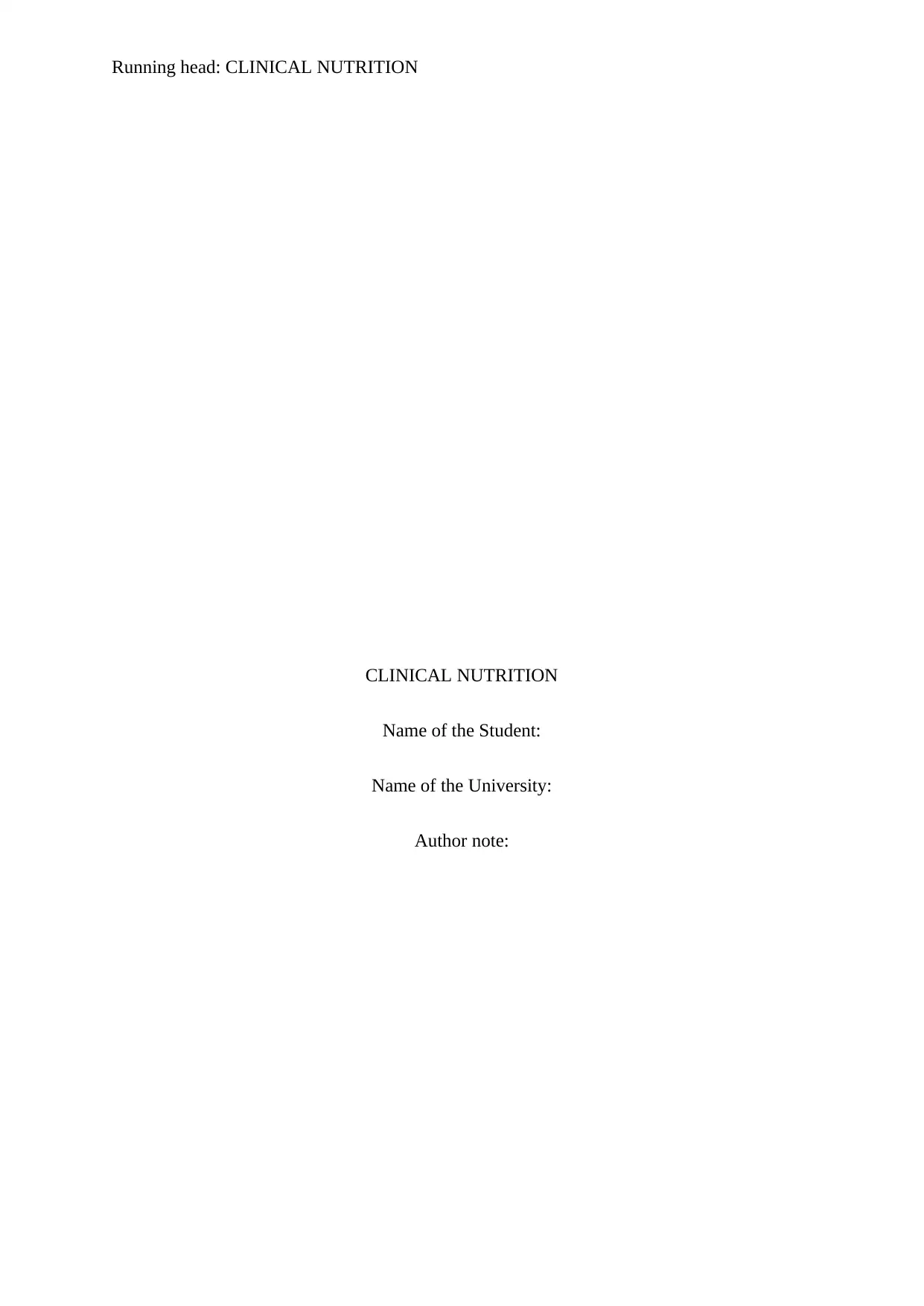
Running head: CLINICAL NUTRITION
CLINICAL NUTRITION
Name of the Student:
Name of the University:
Author note:
CLINICAL NUTRITION
Name of the Student:
Name of the University:
Author note:
Secure Best Marks with AI Grader
Need help grading? Try our AI Grader for instant feedback on your assignments.
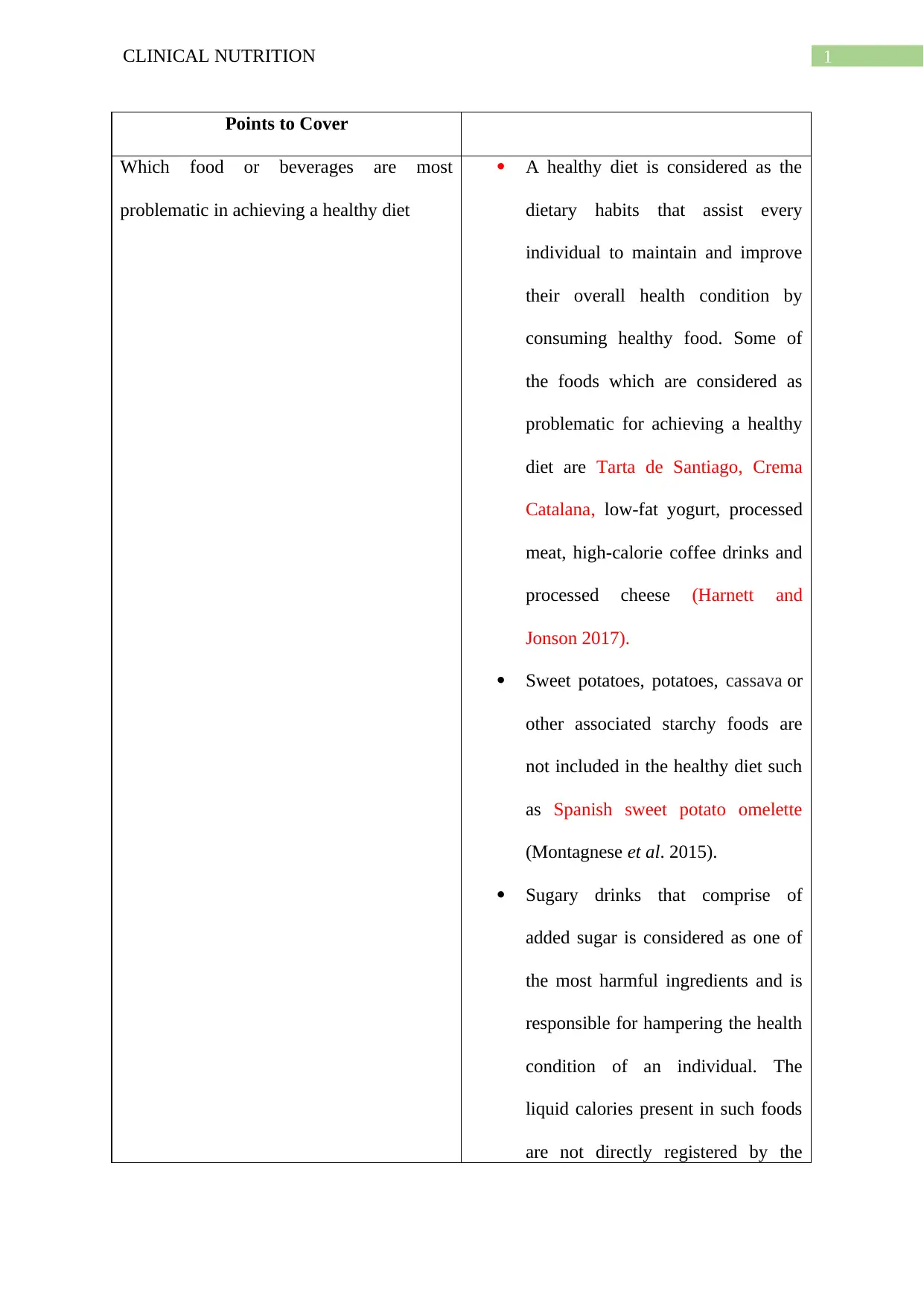
1CLINICAL NUTRITION
Points to Cover
Which food or beverages are most
problematic in achieving a healthy diet
A healthy diet is considered as the
dietary habits that assist every
individual to maintain and improve
their overall health condition by
consuming healthy food. Some of
the foods which are considered as
problematic for achieving a healthy
diet are Tarta de Santiago, Crema
Catalana, low-fat yogurt, processed
meat, high-calorie coffee drinks and
processed cheese (Harnett and
Jonson 2017).
Sweet potatoes, potatoes, cassava or
other associated starchy foods are
not included in the healthy diet such
as Spanish sweet potato omelette
(Montagnese et al. 2015).
Sugary drinks that comprise of
added sugar is considered as one of
the most harmful ingredients and is
responsible for hampering the health
condition of an individual. The
liquid calories present in such foods
are not directly registered by the
Points to Cover
Which food or beverages are most
problematic in achieving a healthy diet
A healthy diet is considered as the
dietary habits that assist every
individual to maintain and improve
their overall health condition by
consuming healthy food. Some of
the foods which are considered as
problematic for achieving a healthy
diet are Tarta de Santiago, Crema
Catalana, low-fat yogurt, processed
meat, high-calorie coffee drinks and
processed cheese (Harnett and
Jonson 2017).
Sweet potatoes, potatoes, cassava or
other associated starchy foods are
not included in the healthy diet such
as Spanish sweet potato omelette
(Montagnese et al. 2015).
Sugary drinks that comprise of
added sugar is considered as one of
the most harmful ingredients and is
responsible for hampering the health
condition of an individual. The
liquid calories present in such foods
are not directly registered by the
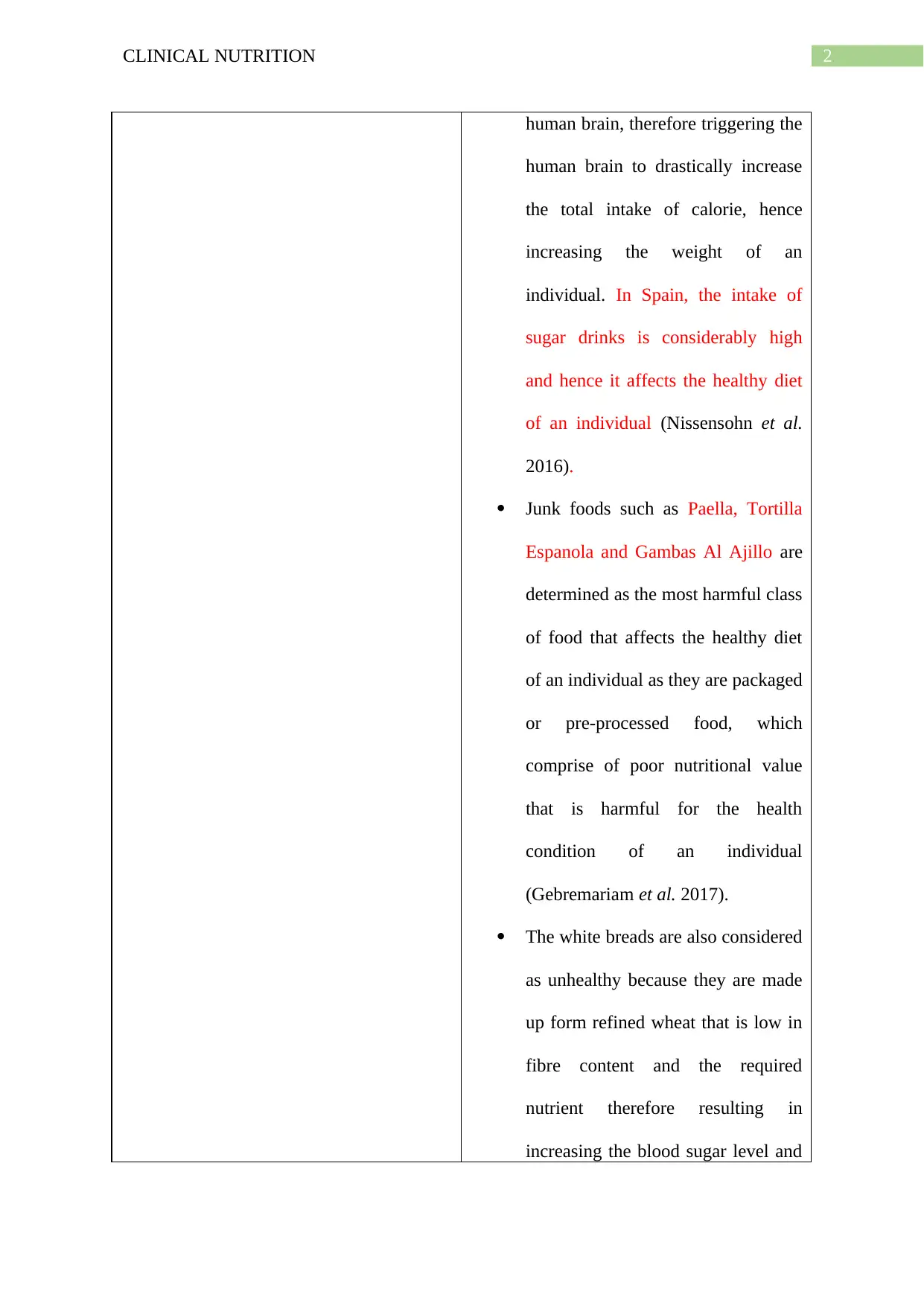
2CLINICAL NUTRITION
human brain, therefore triggering the
human brain to drastically increase
the total intake of calorie, hence
increasing the weight of an
individual. In Spain, the intake of
sugar drinks is considerably high
and hence it affects the healthy diet
of an individual (Nissensohn et al.
2016).
Junk foods such as Paella, Tortilla
Espanola and Gambas Al Ajillo are
determined as the most harmful class
of food that affects the healthy diet
of an individual as they are packaged
or pre-processed food, which
comprise of poor nutritional value
that is harmful for the health
condition of an individual
(Gebremariam et al. 2017).
The white breads are also considered
as unhealthy because they are made
up form refined wheat that is low in
fibre content and the required
nutrient therefore resulting in
increasing the blood sugar level and
human brain, therefore triggering the
human brain to drastically increase
the total intake of calorie, hence
increasing the weight of an
individual. In Spain, the intake of
sugar drinks is considerably high
and hence it affects the healthy diet
of an individual (Nissensohn et al.
2016).
Junk foods such as Paella, Tortilla
Espanola and Gambas Al Ajillo are
determined as the most harmful class
of food that affects the healthy diet
of an individual as they are packaged
or pre-processed food, which
comprise of poor nutritional value
that is harmful for the health
condition of an individual
(Gebremariam et al. 2017).
The white breads are also considered
as unhealthy because they are made
up form refined wheat that is low in
fibre content and the required
nutrient therefore resulting in
increasing the blood sugar level and
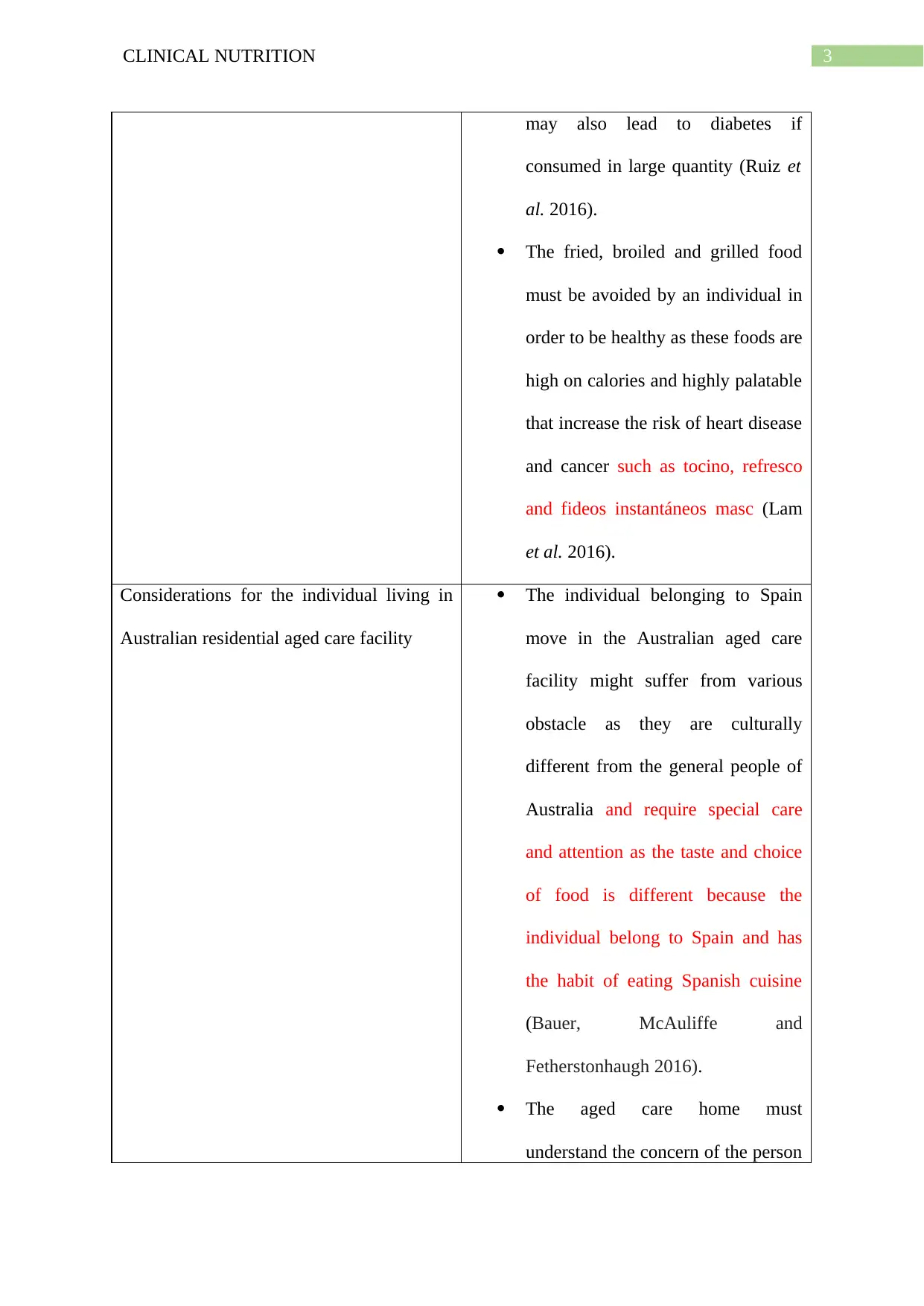
3CLINICAL NUTRITION
may also lead to diabetes if
consumed in large quantity (Ruiz et
al. 2016).
The fried, broiled and grilled food
must be avoided by an individual in
order to be healthy as these foods are
high on calories and highly palatable
that increase the risk of heart disease
and cancer such as tocino, refresco
and fideos instantáneos masc (Lam
et al. 2016).
Considerations for the individual living in
Australian residential aged care facility
The individual belonging to Spain
move in the Australian aged care
facility might suffer from various
obstacle as they are culturally
different from the general people of
Australia and require special care
and attention as the taste and choice
of food is different because the
individual belong to Spain and has
the habit of eating Spanish cuisine
(Bauer, McAuliffe and
Fetherstonhaugh 2016).
The aged care home must
understand the concern of the person
may also lead to diabetes if
consumed in large quantity (Ruiz et
al. 2016).
The fried, broiled and grilled food
must be avoided by an individual in
order to be healthy as these foods are
high on calories and highly palatable
that increase the risk of heart disease
and cancer such as tocino, refresco
and fideos instantáneos masc (Lam
et al. 2016).
Considerations for the individual living in
Australian residential aged care facility
The individual belonging to Spain
move in the Australian aged care
facility might suffer from various
obstacle as they are culturally
different from the general people of
Australia and require special care
and attention as the taste and choice
of food is different because the
individual belong to Spain and has
the habit of eating Spanish cuisine
(Bauer, McAuliffe and
Fetherstonhaugh 2016).
The aged care home must
understand the concern of the person
Secure Best Marks with AI Grader
Need help grading? Try our AI Grader for instant feedback on your assignments.
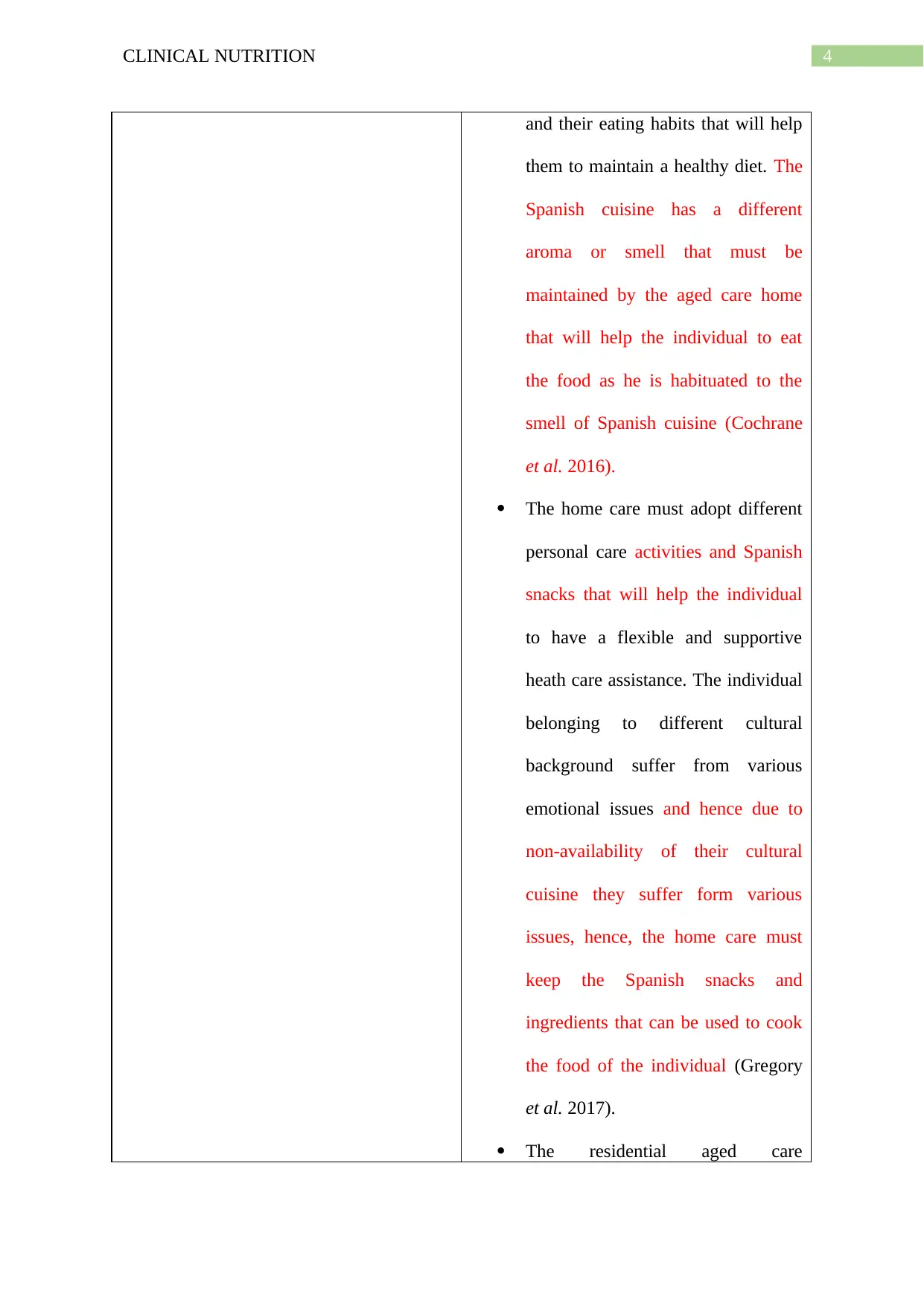
4CLINICAL NUTRITION
and their eating habits that will help
them to maintain a healthy diet. The
Spanish cuisine has a different
aroma or smell that must be
maintained by the aged care home
that will help the individual to eat
the food as he is habituated to the
smell of Spanish cuisine (Cochrane
et al. 2016).
The home care must adopt different
personal care activities and Spanish
snacks that will help the individual
to have a flexible and supportive
heath care assistance. The individual
belonging to different cultural
background suffer from various
emotional issues and hence due to
non-availability of their cultural
cuisine they suffer form various
issues, hence, the home care must
keep the Spanish snacks and
ingredients that can be used to cook
the food of the individual (Gregory
et al. 2017).
The residential aged care
and their eating habits that will help
them to maintain a healthy diet. The
Spanish cuisine has a different
aroma or smell that must be
maintained by the aged care home
that will help the individual to eat
the food as he is habituated to the
smell of Spanish cuisine (Cochrane
et al. 2016).
The home care must adopt different
personal care activities and Spanish
snacks that will help the individual
to have a flexible and supportive
heath care assistance. The individual
belonging to different cultural
background suffer from various
emotional issues and hence due to
non-availability of their cultural
cuisine they suffer form various
issues, hence, the home care must
keep the Spanish snacks and
ingredients that can be used to cook
the food of the individual (Gregory
et al. 2017).
The residential aged care
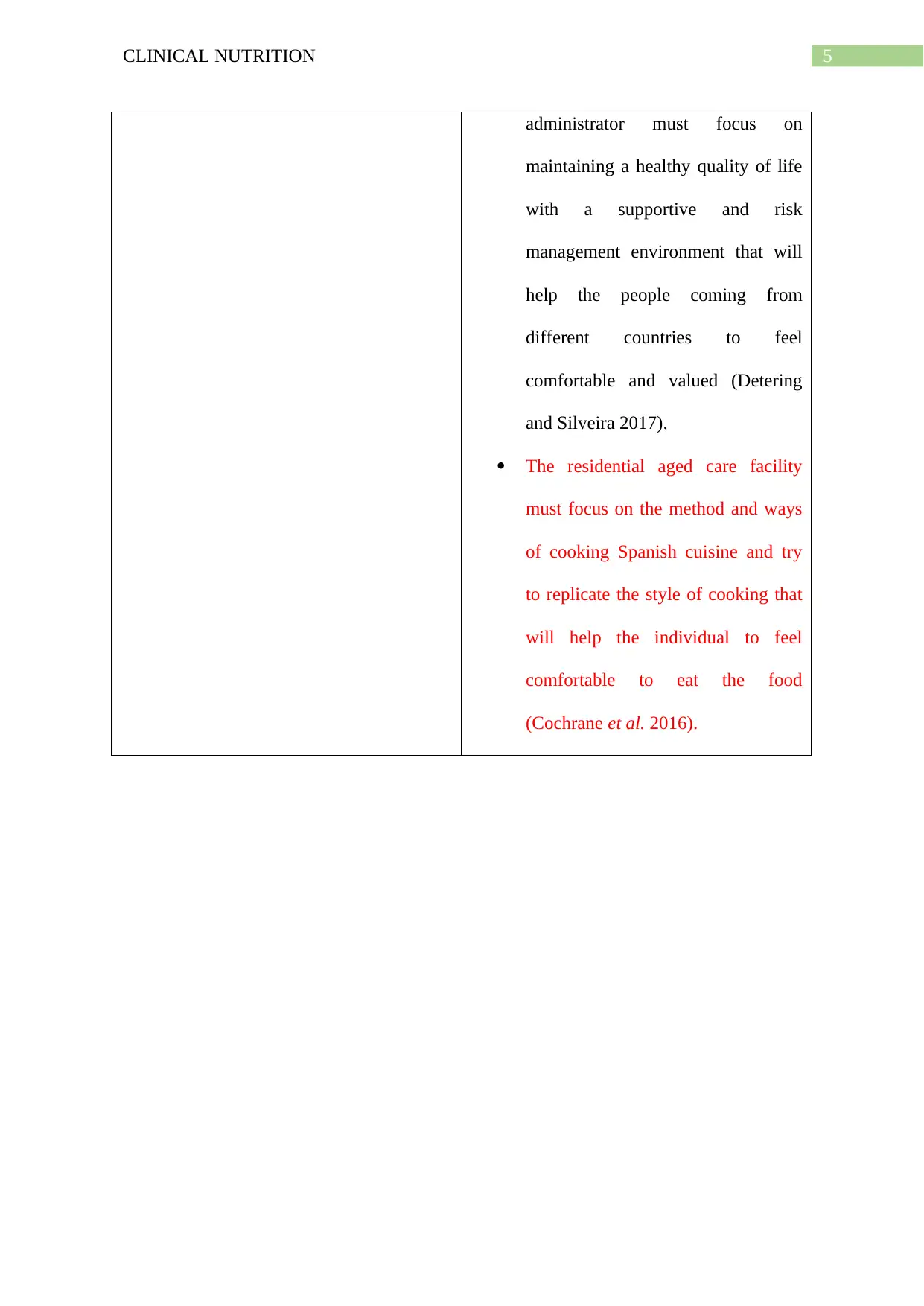
5CLINICAL NUTRITION
administrator must focus on
maintaining a healthy quality of life
with a supportive and risk
management environment that will
help the people coming from
different countries to feel
comfortable and valued (Detering
and Silveira 2017).
The residential aged care facility
must focus on the method and ways
of cooking Spanish cuisine and try
to replicate the style of cooking that
will help the individual to feel
comfortable to eat the food
(Cochrane et al. 2016).
administrator must focus on
maintaining a healthy quality of life
with a supportive and risk
management environment that will
help the people coming from
different countries to feel
comfortable and valued (Detering
and Silveira 2017).
The residential aged care facility
must focus on the method and ways
of cooking Spanish cuisine and try
to replicate the style of cooking that
will help the individual to feel
comfortable to eat the food
(Cochrane et al. 2016).
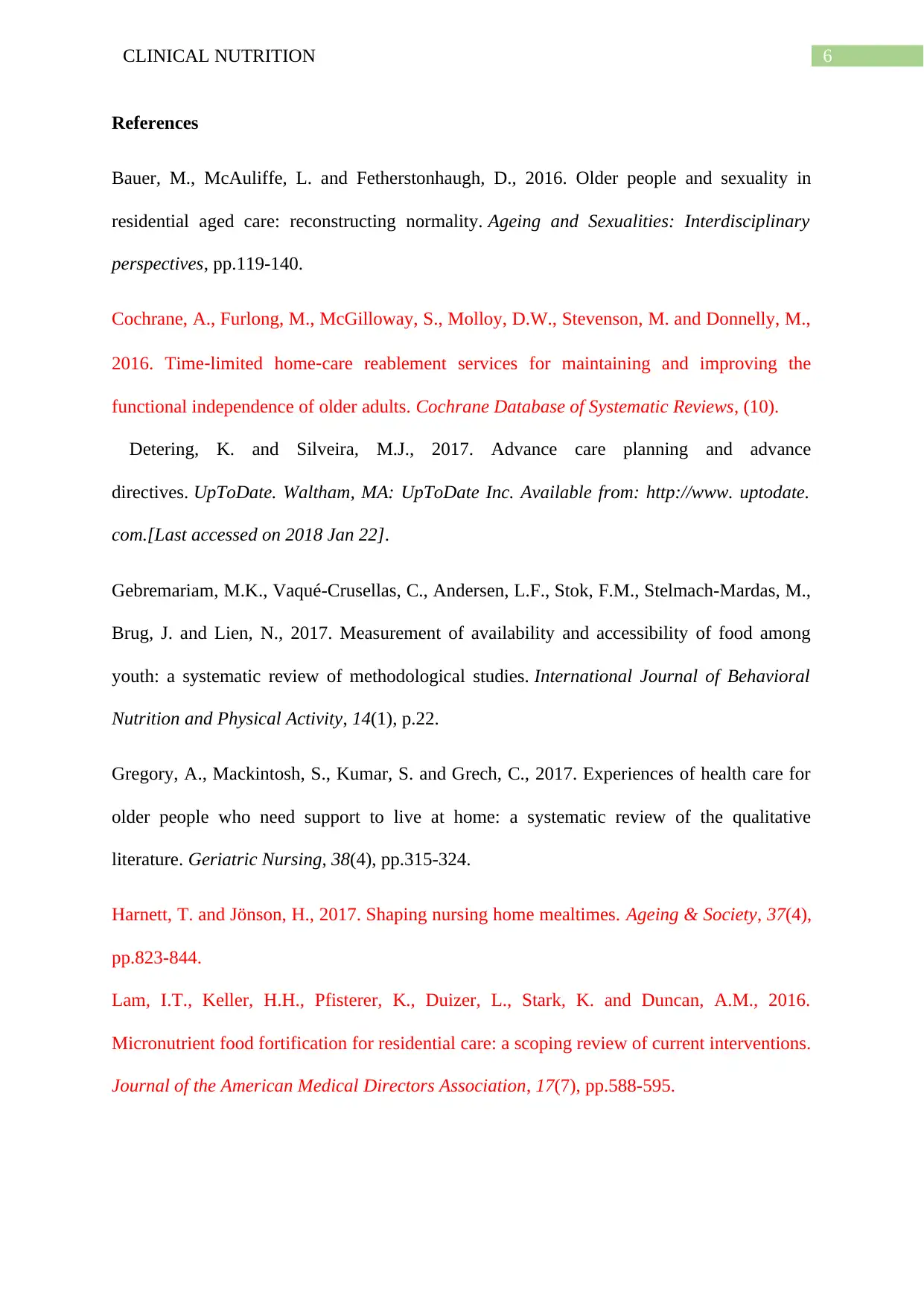
6CLINICAL NUTRITION
References
Bauer, M., McAuliffe, L. and Fetherstonhaugh, D., 2016. Older people and sexuality in
residential aged care: reconstructing normality. Ageing and Sexualities: Interdisciplinary
perspectives, pp.119-140.
Cochrane, A., Furlong, M., McGilloway, S., Molloy, D.W., Stevenson, M. and Donnelly, M.,
2016. Time‐limited home‐care reablement services for maintaining and improving the
functional independence of older adults. Cochrane Database of Systematic Reviews, (10).
Detering, K. and Silveira, M.J., 2017. Advance care planning and advance
directives. UpToDate. Waltham, MA: UpToDate Inc. Available from: http://www. uptodate.
com.[Last accessed on 2018 Jan 22].
Gebremariam, M.K., Vaqué-Crusellas, C., Andersen, L.F., Stok, F.M., Stelmach-Mardas, M.,
Brug, J. and Lien, N., 2017. Measurement of availability and accessibility of food among
youth: a systematic review of methodological studies. International Journal of Behavioral
Nutrition and Physical Activity, 14(1), p.22.
Gregory, A., Mackintosh, S., Kumar, S. and Grech, C., 2017. Experiences of health care for
older people who need support to live at home: a systematic review of the qualitative
literature. Geriatric Nursing, 38(4), pp.315-324.
Harnett, T. and Jönson, H., 2017. Shaping nursing home mealtimes. Ageing & Society, 37(4),
pp.823-844.
Lam, I.T., Keller, H.H., Pfisterer, K., Duizer, L., Stark, K. and Duncan, A.M., 2016.
Micronutrient food fortification for residential care: a scoping review of current interventions.
Journal of the American Medical Directors Association, 17(7), pp.588-595.
References
Bauer, M., McAuliffe, L. and Fetherstonhaugh, D., 2016. Older people and sexuality in
residential aged care: reconstructing normality. Ageing and Sexualities: Interdisciplinary
perspectives, pp.119-140.
Cochrane, A., Furlong, M., McGilloway, S., Molloy, D.W., Stevenson, M. and Donnelly, M.,
2016. Time‐limited home‐care reablement services for maintaining and improving the
functional independence of older adults. Cochrane Database of Systematic Reviews, (10).
Detering, K. and Silveira, M.J., 2017. Advance care planning and advance
directives. UpToDate. Waltham, MA: UpToDate Inc. Available from: http://www. uptodate.
com.[Last accessed on 2018 Jan 22].
Gebremariam, M.K., Vaqué-Crusellas, C., Andersen, L.F., Stok, F.M., Stelmach-Mardas, M.,
Brug, J. and Lien, N., 2017. Measurement of availability and accessibility of food among
youth: a systematic review of methodological studies. International Journal of Behavioral
Nutrition and Physical Activity, 14(1), p.22.
Gregory, A., Mackintosh, S., Kumar, S. and Grech, C., 2017. Experiences of health care for
older people who need support to live at home: a systematic review of the qualitative
literature. Geriatric Nursing, 38(4), pp.315-324.
Harnett, T. and Jönson, H., 2017. Shaping nursing home mealtimes. Ageing & Society, 37(4),
pp.823-844.
Lam, I.T., Keller, H.H., Pfisterer, K., Duizer, L., Stark, K. and Duncan, A.M., 2016.
Micronutrient food fortification for residential care: a scoping review of current interventions.
Journal of the American Medical Directors Association, 17(7), pp.588-595.
Paraphrase This Document
Need a fresh take? Get an instant paraphrase of this document with our AI Paraphraser

7CLINICAL NUTRITION
Montagnese, C., Santarpia, L., Buonifacio, M., Nardelli, A., Caldara, A.R., Silvestri, E.,
Contaldo, F. and Pasanisi, F., 2015. European food-based dietary guidelines: a comparison
and update. Nutrition, 31(7-8), pp.908-915.
Nissensohn, M., Sánchez-Villegas, A., Ortega, R., Aranceta-Bartrina, J., Gil, Á., González-
Gross, M., Varela-Moreiras, G. and Serra-Majem, L., 2016. Beverage consumption habits
and association with total water and energy intakes in the Spanish population: findings of the
ANIBES study. Nutrients, 8(4), p.232.
Ruiz, E., Ávila, J., Valero, T., Del Pozo, S., Rodriguez, P., Aranceta-Bartrina, J., Gil, Á.,
González-Gross, M., Ortega, R., Serra-Majem, L. and Varela-Moreiras, G., 2016.
Macronutrient distribution and dietary sources in the Spanish population: Findings from the
ANIBES study. Nutrients, 8(3), p.177.
Montagnese, C., Santarpia, L., Buonifacio, M., Nardelli, A., Caldara, A.R., Silvestri, E.,
Contaldo, F. and Pasanisi, F., 2015. European food-based dietary guidelines: a comparison
and update. Nutrition, 31(7-8), pp.908-915.
Nissensohn, M., Sánchez-Villegas, A., Ortega, R., Aranceta-Bartrina, J., Gil, Á., González-
Gross, M., Varela-Moreiras, G. and Serra-Majem, L., 2016. Beverage consumption habits
and association with total water and energy intakes in the Spanish population: findings of the
ANIBES study. Nutrients, 8(4), p.232.
Ruiz, E., Ávila, J., Valero, T., Del Pozo, S., Rodriguez, P., Aranceta-Bartrina, J., Gil, Á.,
González-Gross, M., Ortega, R., Serra-Majem, L. and Varela-Moreiras, G., 2016.
Macronutrient distribution and dietary sources in the Spanish population: Findings from the
ANIBES study. Nutrients, 8(3), p.177.
1 out of 8
Related Documents
Your All-in-One AI-Powered Toolkit for Academic Success.
+13062052269
info@desklib.com
Available 24*7 on WhatsApp / Email
![[object Object]](/_next/static/media/star-bottom.7253800d.svg)
Unlock your academic potential
© 2024 | Zucol Services PVT LTD | All rights reserved.





